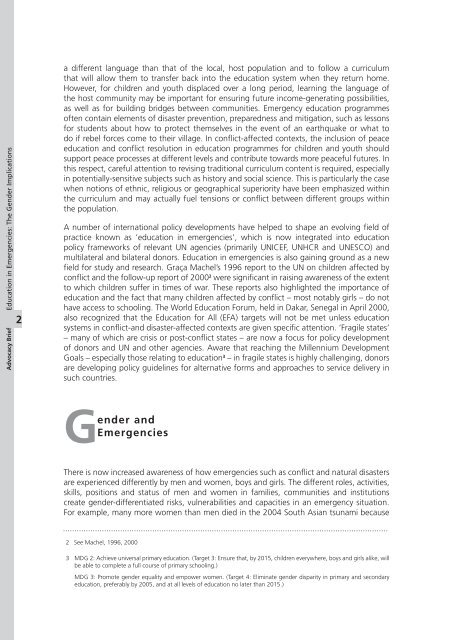Education in Emergencies: The Gender Implications - INEE
Education in Emergencies: The Gender Implications - INEE
Education in Emergencies: The Gender Implications - INEE
- No tags were found...
You also want an ePaper? Increase the reach of your titles
YUMPU automatically turns print PDFs into web optimized ePapers that Google loves.
Advocacy Brief <strong>Education</strong> <strong>in</strong> <strong>Emergencies</strong>: <strong>The</strong> <strong>Gender</strong> <strong>Implications</strong>a different language than that of the local, host population and to follow a curriculumthat will allow them to transfer back <strong>in</strong>to the education system when they return home.However, for children and youth displaced over a long period, learn<strong>in</strong>g the language ofthe host community may be important for ensur<strong>in</strong>g future <strong>in</strong>come-generat<strong>in</strong>g possibilities,as well as for build<strong>in</strong>g bridges between communities. Emergency education programmesoften conta<strong>in</strong> elements of disaster prevention, preparedness and mitigation, such as lessonsfor students about how to protect themselves <strong>in</strong> the event of an earthquake or what todo if rebel forces come to their village. In conflict-affected contexts, the <strong>in</strong>clusion of peaceeducation and conflict resolution <strong>in</strong> education programmes for children and youth shouldsupport peace processes at different levels and contribute towards more peaceful futures. Inthis respect, careful attention to revis<strong>in</strong>g traditional curriculum content is required, especially<strong>in</strong> potentially-sensitive subjects such as history and social science. This is particularly the casewhen notions of ethnic, religious or geographical superiority have been emphasized with<strong>in</strong>the curriculum and may actually fuel tensions or conflict between different groups with<strong>in</strong>the population.A number of <strong>in</strong>ternational policy developments have helped to shape an evolv<strong>in</strong>g field ofpractice known as ‘education <strong>in</strong> emergencies’, which is now <strong>in</strong>tegrated <strong>in</strong>to educationpolicy frameworks of relevant UN agencies (primarily UNICEF, UNHCR and UNESCO) andmultilateral and bilateral donors. <strong>Education</strong> <strong>in</strong> emergencies is also ga<strong>in</strong><strong>in</strong>g ground as a newfield for study and research. Graça Machel’s 1996 report to the UN on children affected byconflict and the follow-up report of 2000 were significant <strong>in</strong> rais<strong>in</strong>g awareness of the extentto which children suffer <strong>in</strong> times of war. <strong>The</strong>se reports also highlighted the importance ofeducation and the fact that many children affected by conflict – most notably girls – do nothave access to school<strong>in</strong>g. <strong>The</strong> World <strong>Education</strong> Forum, held <strong>in</strong> Dakar, Senegal <strong>in</strong> April 2000,also recognized that the <strong>Education</strong> for All (EFA) targets will not be met unless educationsystems <strong>in</strong> conflict-and disaster-affected contexts are given specific attention. ‘Fragile states’– many of which are crisis or post-conflict states – are now a focus for policy developmentof donors and UN and other agencies. Aware that reach<strong>in</strong>g the Millennium DevelopmentGoals – especially those relat<strong>in</strong>g to education – <strong>in</strong> fragile states is highly challeng<strong>in</strong>g, donorsare develop<strong>in</strong>g policy guidel<strong>in</strong>es for alternative forms and approaches to service delivery <strong>in</strong>such countries.<strong>Gender</strong> and<strong>Emergencies</strong><strong>The</strong>re is now <strong>in</strong>creased awareness of how emergencies such as conflict and natural disastersare experienced differently by men and women, boys and girls. <strong>The</strong> different roles, activities,skills, positions and status of men and women <strong>in</strong> families, communities and <strong>in</strong>stitutionscreate gender-differentiated risks, vulnerabilities and capacities <strong>in</strong> an emergency situation.For example, many more women than men died <strong>in</strong> the 2004 South Asian tsunami because See Machel, 1996, 2000 MDG 2: Achieve universal primary education. (Target 3: Ensure that, by 2015, children everywhere, boys and girls alike, willbe able to complete a full course of primary school<strong>in</strong>g.)MDG 3: Promote gender equality and empower women. (Target 4: Elim<strong>in</strong>ate gender disparity <strong>in</strong> primary and secondaryeducation, preferably by 2005, and at all levels of education no later than 2015.)
















